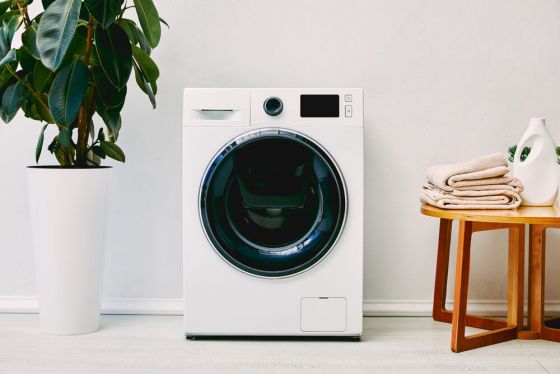When it comes to buying a new laundry appliance, one of the most important decisions is whether to choose a front loader or a top loader washing machine. So, which is best? We cover everything you need to know below.
Front loader vs top loader washing machines: how do they work?
The main difference between a front loader and top loader washing machine is the design: a front loader washing machine has its door located at the front of the machine, while a top loader washing machine has its door at the top.
There are other differences between front and top loaders worth noting (we’ll cover them in this guide), including:
- Design: Front loader machines have no agitator and instead use the rotation of the tub combined with gravity to mix your clothes with water and detergent. The tumbling action is said to be more efficient, gentler on your fabrics and garments and less likely to tangle and become off-balanced.
- Energy and water efficiency: Front loaders are typically more energy and water efficient than top loaders. According to Energy Australia, front loaders use up to 60 percent less energy and water than top loaders, which can lead to significant savings on your power bill.
- Cost: The price of a top loader and front loader depends on the model, features and technology. Generally, one is not more expensive than the other when comparing capacity.
Front loader vs top loader washing machine: which performs best?
It’s widely accepted that front loader washing machines offer superior washing performance, compared to top loader washers. The tumbling action of the drum in front loaders, coupled with thermal action (water temperature) and the ability to wash specific fabrics with tailored settings delivers a better clean.
Do front loader washing machines take longer to wash?
Yes, front loaders have longer wash cycles than top loaders because they combine the rotation of the drum with a shallow pool of water and detergent to wash your clothes. Although this takes more time, it uses less energy and water and is gentler on garments. Top loaders need to use more water to ensure that clothes get sufficiently wet during the cycle for a proper clean.
Is it cheaper to run a front loader or a top loader washing machine? Find out in Canstar Blue’s running cost analysis for washing machines.
Front loader vs top loader washing machine: which is cheapest?
The price of your washing machine will depend on the model and the built-in technology. Newer models, regardless of whether they’re top loader or front loaders, will generally be more expensive. The capacity of the machine – how many kilos of clothes it can fit in a load – will also influence price, as will settings, unique features and the brand.
Front loader vs top loader washing machine: which is more energy efficient?
Front loader washing machines can use up to 60% less energy and water than top load washing machines, according to EnergyAustralia. A lot of new front loader models also come with additional energy-saving features, including programmable timers to schedule your washing during off-peak times (when electricity is cheaper ) and cold-water cycles with lower spin speeds.
Washing machines are included in the compulsory Energy Star rating scheme, which means all models have to display a star rating that tells you how efficient a model is relative to other models of the same size. Most household appliances are given between one and six stars for energy efficiency.
Front loader vs top loader washing machine: which has more functions and features?
Front loader washing machines have more functions and cycle options built-in compared to top loader washing machines, including (but not limited to):
- wash cycles for specific fabrics (i.e. wool, cotton, bedding, etc.)
- eco or quick modes
- automatic detergent dispenser
- steam cycles to sanitise clothes
- self-cleaning cycles
- programmable timers
- Wi-Fi connectivity and remote control
In contrast, top loader washing machines are simpler in design, which makes them easier and cheaper to repair. While some newer models do offer high-tech features like steam cycles and voice control, most have fewer cleaning cycle options to choose from.

You may also be interested in:
Heat pump vs condenser dryer: Which is best?
Everything you need to know about twin tub washing machines
How to clean your washing machine
Front loader vs top loader washing machine: which is more reliable?
Not only are front loaders more effective at removing hard stains from clothes and considered to be gentler, but they also tend to be more reliable overall, especially in terms of getting consistently good cleaning results and preserving energy and water in the long term. That said, top loaders are simpler in design and therefore easier to use and repair, while front loader washers are more complex to repair as there are more moving parts.
Top loader or front loader washing machine: which is better?
If your priorities are fast-action and minimal effort to wash each laundry load without having to get down to the nitty gritty of specialised cycles, then a top loader washing machine may be best suited to your needs.
On the other hand, if you value cleaning efficiency and garment care over a fast wash, then a front loader washing machine is the way to go. A front loader typically comes with more wash cycles and customised settings for different fabrics and to reduce overall energy consumption, meaning you get more bang for your buck in terms of usage and reduced utility bills in the long run.



Share this article